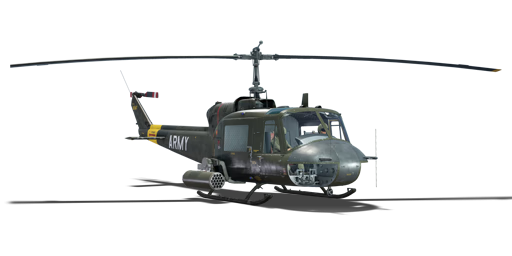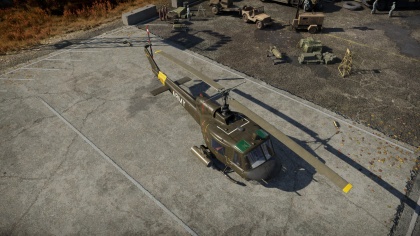UH-1B
Contents
| This page is about the American utility helicopter UH-1B. For other uses, see UH-1 (Family). |
Description
The UH-1B is a Rank V American utility helicopter
with a battle rating of 9.0 (AB) and 8.7 (RB/SB). This helicopter was introduced in Update 1.81 "The Valkyries".
General info
Flight Performance
Describe how the aircraft behaves in the air. Maximum speed, manoeuverability, speed and allowable loads - these are the most important characteristics of the vehicle.
| Characteristics | |||
|---|---|---|---|
| Stock | |||
| Max Speed (km/h at ?,000 m) |
Max altitude (meters) | ||
| AB | RB | ||
| ? | ? | 5900 | |
| Upgraded | |||
| Max Speed (km/h at ?,000 m) |
Max altitude (meters) | ||
| AB | RB | ||
| ? | ? | 5900 | |
Survivability and armour
Examine the survivability of the helicopter. Note how vulnerable the structure is and how secure the pilot is, how many engines the vehicle has. Describe the armour, if there is any, also mention the vulnerability of other critical aircraft systems.
Armaments
Suspended armament
The UH-1B can be outfitted with the follwing ordnance:
- 38 x FFAR Mighty Mouse Rockets
- 72 x FFAR Mighty Mouse Rockets
- 6 x AGM-22 missiles
- 2 x 7.62 mm M134 Minigun
- 1 x 7.62 mm M134 Minigun and 38 x FFAR Mighty Mouse Rockets
The UH-1B is a true workhorse utility helicopter which can pack a punch with several different weapons load-outs and configurations utilising rockets, guns and missiles. Selecting a single type of weapon to fly into battle with or mixing it up will allow the pilot to mix and match as necessary for the upcoming battle. The M134 with it's almost 6,000 rounds-per-minute fire were an early fixture to helicopters as they can fly low and slow allowing them to pivot on the battlefield as neccessary to take out personnel and light armored vehicles. While initially not doing much damage being rifle calibre bullets, if the enemy does not move to avoid the fire, they will start taking on more and more damage. The M134 is also good for clearing trees and exposing hiding positions of armored vehicles providing a better shot for harder hitting weapon systems.
Due to weight and recoil issues of autocannons, helicopters typically have a work around which allow them to have similar firepower without the drawbacks. The UH-1B can be outfitted with the FFAR Mighty Mouse rockets which just needed to be aimed at the target and fired. The Mighty Mouse rockets when launched have fins which flip out to spin-stabilize them and guide them in as straight of a path as possible without any further guidance. While a single rocket can inflict some serious damage including shooting down bomber aircraft, typically one rocket will not be enough. Effectively the rockets work like a cannon with a shotgun pattern, where they pack a punch like a cannon, but have the accuracy of a shotgun and typically requires firing off several at a time to ensure a few will actually hit the target. The UH-1B can be outfitted with two amounts of the rockets, either 38 when stock or mixed with a M134 Minigun load-out or a total of 78 rockets when utilising them on both pylons. With the ability of the helicopter to swoop in and reorient towards a target in a matter of seconds, rockets can be streaking towards their target before the enemy has the chance to either notice or even swing a gun around to counter. Mighty Mouse rockets pack a punch, however may not have enough ummph to get through some of the thicker skinned vehicles found on the battlefield.
Not without a heavy-hitter, the UH-1B can dish out damage with unguided rockets, however to tackle some of the armored goliaths rolling around on the battlefield, it needs something bigger! To meet this need, six AGM-22 manual to command line of sight (MCLOS) wire-guided anti-tank missles are installed. Knowing where an enemy tank is allows the helicopter pilot to take evasive action while setting up to fire off a missile. Using structures and terrain as a shield, the helicopter pilot can fire off a missile and then guide it to the target without being a target itself. It is important to fire, hit and then move as a sitting helicopter makes for an easy target and while guiding a missile to the target, the pilot can get tunnel vision and not realise inbound threats to their position.
Usage in battles
Describe the tactics of playing in the helicopter, the features of using vehicles in a team and advice on tactics. Refrain from creating a "guide" - do not impose a single point of view but give the reader food for thought. Examine the most dangerous enemies and give recommendations on fighting them. If necessary, note the specifics of the game in different modes (AB, RB, SB).
Modules
| Tier | Flight performance | Survivability | Weaponry | |||
|---|---|---|---|---|---|---|
| I | Compressor | Flak jacket | Gun pod XM-18 | XM159 | ||
| II | Helicopter frame | M156 AGM | M129 | |||
| III | Engine | Replacing helicopter blades | New 7 mm MGs | |||
| IV | Cover | Gun pod XM-21 | New 40 mm cannons | |||
Pros and cons
Pros:
- Varied weapon options allowing for customization to pilot's preference
- Good visibility from cockpit
Cons:
- Exposed tail rotor blades, can come into contact with objects and break
- Not built for speed
History
The United States Army identified in 1952 a need for a new general utility helicopter which could also serve as a medical evacuation (MEDEVAC) and instrument training helicopter too. The current inventory of helicopters had several flaws which the Army wanted to over come including being too large, underpowered or extremely complex to maintain. The Army wanted a workhorse that was easy to maintain and have fairly small profile. Twenty companies participated in the bidding process and in 1955, Bell Helicopter was selected to build three copies of the Model 204 for evaluation and this version was designated XH-40 (Experimental Helicopter-40).
The XH-40 was built with the Lycoming YT52-L-1 (LTC1B-1) turbo engine helicopter, the first non-piston helicopter tested by the military and first flew in 1956. Even before the first prototype had flown, the Army put in an order for six YH-40 service test aircraft in which they could field test to determine how it would work under military unit operations. Proving successful, Bell was awarded a contract to build another 100 helicopters which were designated HU-1A (Helicopter Utility-1A) and hence was officially named ‘‘Iroquois’’. Iroquois ended up being a mouthful for people to say, so a nickname developed from the HU-1 designation which ended up being pronounced as “Huey” and stuck. In September 1962, the Department of Defense changed up the aircraft identification system to streamline between all of the different aircraft and their variations and changed the HU-1 to UH-1 (Utility Helicopter-1). Even with the change, the official Army name and the new DOD designation was almost never used as Huey was so well recognized as the name, that is what was to most people.
Unfortunately, with all of the positive feedback received for the YH-40, service tests performed by the Army found the T53-L-1A engine was found to be underpowered and could not perform to the level that was needed. Bell proposed to swap the T53-L-1A engine with the T53-L-5 engine, upping the shaft horsepower from 770 to 960 (570 kW to 720 kW) and extended the cabin to accommodate more people, up to 7 passengers or four stretchers and a medical attendant. The first production of the new helicopter UH-1B was delivered for service in 1961.
Several aerodynamic deficiencies of an armed UH-1B was identified specifically not having enough engine power to lift the necessary weapons systems. The UH-1C was developed to overcome these problems by upgrading the helicopter with the T53-L-11 engine which had 1,100 shaft horsepower or 820 kW. The UH-1B helicopters which were in the service of the Army at the time were also upgraded with the new engine. Several adjustments were made to the UH-1C which included a new rotor-system, however like many things which are upgraded, domino effect also requires other components and modules to also be upgraded. A larger diameter rotor was installed to counter blade stall during dives which required the tail boom to be extended and larger synchronized elevators to be added. While operating in military operations, it was determine necessary to add a redundant hydraulic control system to allow for continued operation in the event of failure in one system. Larger fuel tanks allowed for further range with the total useful load capacity topping out at 4,673 lbs (2,120 kg). Mid-1966 saw the line production of the fully upgraded UH-1C helicopter.
Huey model 204 helicopters were a huge success and were put to use in several different capacities, however, the Army wanted another version which facilitated the carrying of more troops which spawned the Model 205. Bell adjusted by extending the HU-1B’s fuselage by a total of 41 in (104 cm), boxed in the transmission and was able to add four more seats, two on each side of the transmission box facing out the side doors. With the side doors being easily removable, options to fly without doors made for quick loading and unloading of the helicopter which could now accommodate 15 persons, including the crew and could now hold six stretchers and a medic. First flown in 1961, the 205 took on many of the same upgrades as the UH-1C including the T53-L-11 which enabled usage of multiple types of fuel. Prototypes of this helicopter were designated YUH-1D and the final assembly line aircraft was called the UH-1D.
This helicopter while still under evaluation the Army sent it to Vietnam in 1962 where it began operations. Initially only required as general utility, MEDEVAC, and an instrument trainer, this helicopters role expanded to also include but not limited to air assault, cargo transport, search and rescue, electronic warfare and eventually ground attack.
During the Vietnam War the UH-1 earned several other nick-names other than “Huey” which quickly identified to troops what role the helicopter had been outfitted for. Gunship versions of the UH-1s were identified as “Frogs” or “Hogs” if they carried rockets while if they just carried guns they were identified as “Cobras”. Troop transport versions were called “Slicks” due to weapon pods being absent on the external pylons while they did retain their door gunners. Later in the war from 1967 to 1968, the gunship Huey’s were replaced by the new AH-1 attack helicopters.
Media
An excellent addition to the article will be video guides, as well as screenshots from the game and photos.
See also
Links to the articles on the War Thunder Wiki that you think will be useful for the reader, for example:
- reference to the series of the aircraft;
- links to approximate analogues of other nations and research trees.
External links
Paste links to sources and external resources, such as:
- topic on the official game forum;
- encyclopedia page on helicopter;
- other literature.
| USA helicopters | |
|---|---|
| Attack | |
| Black Hawk | MH-60L DAP |
| Choctaw | H-34 |
| Cobra | AH-1F · AH-1G · AH-1Z |
| SuperCobra | AH-1W |
| Kiowa | OH-58D |
| Little Bird | AH-6M |
| Apache | YAH-64 · AH-64A · ▃AH-64A Peten · AH-64A (GR) · AH-64D |
| Utility | |
| Huey | UH-1B · UH-1C · UH-1C XM-30 |





